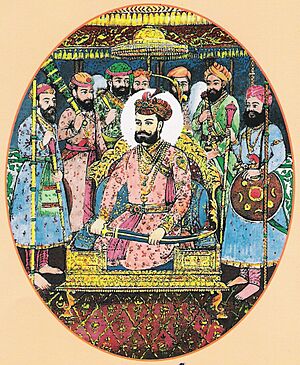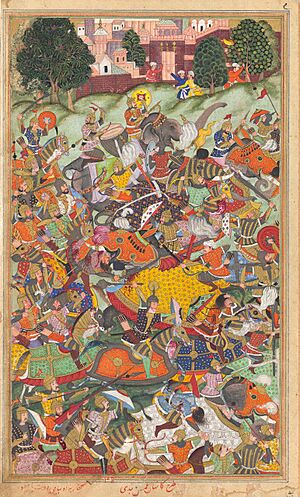Hemu facts for kids
Quick facts for kids Hemu |
|||||
|---|---|---|---|---|---|
| Maharaja Hemchandra Vikramaditya | |||||

A posthumous portrait of Hemu
|
|||||
| Rule | 7 October – 5 November 1556 | ||||
| Coronation | 7 October 1556 | ||||
| Predecessor | Adil Shah Suri | ||||
| Successor | Akbar | ||||
| Born | 1501 Alwar, Rajasthan |
||||
| Died | 5 November 1556 Panipat, Haryana |
||||
|
|||||
| Father | Rai Puran Das | ||||
| Religion | Hinduism | ||||
Hemu (also known as Hemu Vikramaditya and Hemchandra Vikramaditya; 1501 – 5 November 1556) was an important Indian emperor. He was a general and chief minister for Adil Shah Suri of the Sur Empire. This was a time when the Mughals and Afghans were fighting for control of North India.
Hemu was a skilled military leader. He won 22 battles against Afghan rebels and Mughal forces. He even defeated Akbar's army in the Battle of Delhi on October 7, 1556. After this victory, he became an emperor and took the title of Vikramaditya. However, his rule was very short. About a month later, he was hurt in the Second Battle of Panipat. He was captured and then died.
Contents
Early Life of Hemu
Hemu came from a simple family. He was born in a Hindu family in Alwar, Rajasthan, around 1501. His father was Rai Puran Bhargav. Because his family didn't have much money, Hemu started working young. He began as a tradesman, selling things like saltpetre. He spent his childhood in Rewari, a town near Delhi.
Hemu's Rise to Power
Hemu started his career as a seller of goods. Later, he became a trader or a weighman in the market. After Sher Shah Suri died in 1545, his son Islam Shah became the ruler. During Islam Shah's time, Hemu gained more important roles. He became the superintendent of the market in Delhi. He also gained some military experience.
Hemu was later made the Chief of Intelligence and Superintendent of Posts. This meant he was in charge of gathering information and managing mail. Islam Shah saw Hemu's skills as a soldier. He gave Hemu important responsibilities, similar to a high-ranking officer.
Islam Shah died in 1553. His young son, Firoz Khan, became ruler but was killed quickly. Adil Shah Suri then took over. Hemu supported Adil Shah. His success in battles led him to become the Chief Minister. This meant he was the main advisor and manager of the state. He handled appointments, dismissals, and justice in the Shah's court.
Hemu's Military Campaigns
Hemu was not only a great administrator but also a brilliant military leader. He won 22 battles for Adil Shah. Many of these fights were against other Afghans who had rebelled. For example, he fought Taj Khan Karrani multiple times. Karrani tried to escape from Gwalior to the east. Hemu chased him and defeated him at Chibramau and again at Chunar. Even though Karrani escaped, Hemu kept chasing him all the way to Bengal.

In 1555, the Mughals, led by Humayun, took back Delhi and Agra. Humayun died in January 1556. This was a perfect chance for Hemu to strike against the Mughals. He quickly marched from Bengal. He drove the Mughals out of several cities, including Bayana, Etawah, and Agra. The governor of Agra even ran away without a fight when he heard Hemu was coming.
Hemu's most famous victory against the Mughals happened soon after. It was the Battle of Tughlaqabad.
Battle of Tughlaqabad
Tardi Beg Khan, who was Akbar's governor in Delhi, asked for help. He told his leaders that Hemu had captured Agra and was planning to attack Delhi. Akbar's regent, Bairam Khan, sent his best officer, Pir Muhammad Sharwani, to Delhi. Tardi Beg Khan also gathered all Mughal nobles nearby. They decided to fight Hemu.
Hemu reached Tughlaqabad, a village outside Delhi. There, he met Tardi Beg Khan's forces. The Mughals were outnumbered. Hemu's army included 1,000 war elephants, 50,000 cavalry, and many cannons.
The Mughal cavalry attacked first and pushed back Hemu's forces. They captured 400 elephants and killed many of Hemu's soldiers. Thinking they had won, many Mughal soldiers left to loot Hemu's camp. This left Tardi Beg Khan with few guards. Hemu had kept 300 strong elephants and horsemen as a reserve. He quickly used this chance to charge at Tardi Beg Khan. The huge elephants and cavalry scared many Mughal officers, who ran away. Tardi Beg Khan also fled.
Hemu's attack was made stronger by new soldiers from Alwar. When the Mughal soldiers who had been chasing the enemy returned, they saw the battle was lost. They also ran away. Hemu took control of Delhi after this battle on October 7, 1556.
Hemu as Raja Vikramaditya
After taking Delhi, Hemu declared himself emperor. He took the title of Vikramaditya. This title had been used by many powerful Hindu kings in India's past.
Historians have different ideas about what this meant. Some believe Hemu did not declare himself fully independent. They point out that Mughal writers of the time did not clearly say so. Also, Hemu's army was mostly made up of Afghans. Some Afghans were unhappy with his rise to power.
Other historians believe Hemu wanted to be an independent ruler. They say he even had coins made in his name. However, he still pretended to be loyal to Adil Shah.
Whether he was fully independent or not, Hemu Vikramaditya's rule was very short. He would face the Mughals again just a month later. This next battle would be at Panipat, where Akbar's grandfather, Babur, had won a big victory 30 years before.
Second Battle of Panipat

When Akbar heard about the loss at Tughlaqabad, he quickly went towards Delhi. A Mughal force, led by Ali Quli Khan Shaibani, found Hemu's artillery. It was being moved with only a few guards. The Mughals easily captured all of Hemu's cannons. This was a big loss for Hemu.
On November 5, 1556, the Mughal army met Hemu's army at Panipat. Akbar and Bairam Khan stayed behind the main battle. Hemu led his army himself, riding on a large elephant named Hawai.
The battle was very fierce. Hemu's army was doing well. Both sides of the Mughal army were pushed back. Hemu then moved his war elephants and cavalry forward to crush the Mughal center. Hemu was very close to winning. But then, a Mughal arrow hit him in the eye. He fell unconscious. This caused panic in his army. His soldiers broke formation and ran away. The battle was lost. Many soldiers died, and more were killed while fleeing.
Hemu's Death
The elephant carrying the wounded Hemu was captured. It was brought to the Mughal camp. Bairam Khan asked the 13-year-old Akbar to behead Hemu. Some stories say Akbar refused to kill an unconscious man. However, other historical accounts say Akbar did follow Bairam Khan's advice. He beheaded Hemu and took the title of Ghazi, meaning a warrior for faith. Hemu's head was sent to Kabul. His body was displayed on a gate in Delhi. A tower was later built using the heads of other dead soldiers.
Aftermath of the Battle
Hemu's family lived near Alwar. A Mughal officer named Pir Muhammad captured them. Pir Muhammad offered to let Hemu's elderly father live if he changed his religion to Islam. Hemu's father refused, saying he had worshipped his God for 80 years. He was then executed. However, Hemu's wife managed to escape.
After Hemu's death, Adil Shah's luck also changed. He was defeated and killed in April 1557. The Mughals gained 120 of Hemu's war elephants from the battle. These powerful animals became a key part of the Mughal army.
Hemu's Legacy

Hemu's journey from his simple beginnings to becoming an emperor is a remarkable story. He rose from a small town to take the imperial title of Raja Vikramaditya. If not for the unlucky arrow that hit him, he might have brought back an old Indian kingly tradition. However, his army was mostly Afghans, and some of them were not happy with his rule. This makes historians wonder if he could have kept his royal status for long.
Even Hemu's enemies admired him. Abu'l-Fazl, a Mughal historian, praised his courage and spirit. He wished that Akbar had kept Hemu alive as a prisoner. He thought Hemu could have been convinced to join the Mughal army, where he would have done great things.
Hemu's supporters built a memorial for him at Panipat. It is known as Hemu's Samadhi Sthal.
See also
- Chunar Fort
- Third Battle of Panipat


